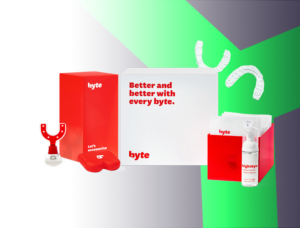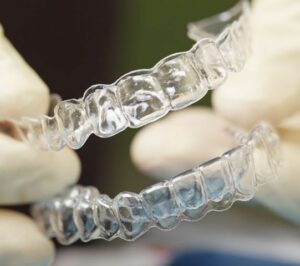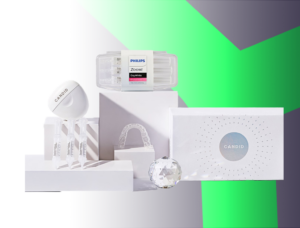
Have you ever wondered how aligners work their magic on your smile? While their invisibility and convenience are captivating, understanding the science behind their power is equally important. Knowing how aligners gently guide your teeth into place empowers you to make informed decisions about which orthodontic treatment to choose.
Biomechanics, material science, and technology that drives successful smile transformations are covered in scientific articles. Luckily, you don’t need a Ph.D. to understand the advancements behind aligner technology. I will explain all you need to know about how aligners move teeth here. The skepticism about aligner efficiency can be put to rest once and for all.
How Do Aligners Work?
Clear aligners are special trays that push teeth gently, guiding them bit by bit into the proper position. Each tray is a little different, enabling safe and efficient teeth movement. It is important to note that the aligner technology relies on careful forces to guide your teeth into their new spots, following how your mouth works.
Research in the Journal of Orthodontic Smile reaffirms clear aligners as a safe, effective, and discreet way to straighten teeth for a beautiful smile. Unlike braces, they’re comfy and nearly invisible. You can take them out for eating and brushing, making it easier to get a nice smile.
How Do Clear Aligners Straighten Teeth?
The near-invisibility of clear aligners is a deciding factor for many patients when choosing between braces or aligners. Many clear aligners are crafted from a see-through plastic material called thermoplastic. It’s hardly noticeable when worn, unlike traditional braces that make a noticeable wiring on one’s teeth. This material is custom-molded to fit snugly over your teeth, resembling a transparent mouthguard.
The precision of the fit is crucial — it ensures that the aligners apply pressure and force evenly. That is the only way to guide your teeth’s movement, nudging them slowly into their correct positions over time. The gradual movement of teeth with clear aligners happens through a series of custom trays. Each tray in the series is slightly modified to encourage the targeted tooth movements required at that stage.
As you progress through these aligner trays, your teeth gradually shift a fraction of a millimeter at a time. This steady progress is crucial in aligner treatment and is the marking difference between retainers and aligners. Unlike retainers that primarily maintain the achieved alignment, aligners actively work to shift teeth, making a significant difference in correcting misalignments.
Can Clear Aligners Move Teeth Faster Than Traditional Braces?
Concerned about how long to wear clear aligners? The advised duration is typically 20 to 22 hours daily, aiding in effective teeth alignment over time. The duration of treatment varies but typically lasts 12-18 months, while braces could take up to 24 months to correct severe misalignment. Consulting an orthodontist ensures the best plan for individual needs.
In comparison to braces, clear aligners offer advantages in comfort and removability. They are made from a durable polymer, which is comfortable as opposed to the wires and attachments of braces. Braces are attached to your teeth constantly, making cleaning and eating a hassle. You can easily remove the aligners for eating and cleaning.
Limitations to How Much Clear Aligners Can Move Teeth
Complex cases often demand strict patient compliance for optimal results. The efficacy of clear aligners to move teeth hinges on the specific nature of dental misalignments and is influenced by stability and overall gum health.
Clear aligners excel in correcting mild to moderate dental issues by straightening rotated or tipped teeth. By putting gentle pressure on your teeth, they are effective in closing gaps, enhancing both appearance and bite functionality. However, for more intricate dental problems like widening teeth or severe rotations (beyond 45°), traditional braces might offer better solutions.
Challenging Types of Tooth Movements for Clear Aligners
Clear aligners handle movements like rotation and moderate adjustments well but can struggle with complex movements like extrusion, torquing, and widening teeth. They might face challenges with extruding front teeth, rotating conically-shaped teeth, and translating them due to aligner material constraints and the need for strict patient adherence.
Extensive interdental corrections or open bites can also be trickier for aligners. So, while suitable for many cases, they may not match the effectiveness of traditional braces for intricate movements. Consulting an orthodontist is vital for tailoring the best treatment plan based on individual needs.
Cost Compared to Braces
When deciding between clear aligners and traditional braces, cost plays a significant role. Braces tend to have a lower upfront expense, ranging from $1,800 to $10,000, covering consultation, brackets, wires, and adjustments.
If you are looking for an effective way to fix teeth without braces, go for aligners, which start around $1,000, and extend up to $10,000, encompassing consultation, 3D scans, aligner sets, and potential refinements.
Both options often provide payment plans, facilitating the affordability of treatment over time. Long-term expenses differ: braces might demand more frequent adjustments and checkups, potentially incurring additional costs due to breakage. In contrast, clear aligners generally involve fewer appointments but could require extra aligner sets if the treatment plan changes.
Maintenance varies as well. Braces necessitate special cleaning and dietary restrictions, and post-treatment retainers are usually recommended. Clear aligners are simpler to maintain with regular brushing, making them cheaper alternatives to braces.
Are All Aligners the Same?
Aligners offer a discreet, comfortable alternative to traditional braces, promising effective results for moving teeth without the metal. Clear aligners offer an innovative path to gently and safely move your teeth, but not every brand delivers the same exceptional experience. You can opt for Byte, Candid, or AlignerCo invisible aligners. Among these, Byte stands out as the ultimate choice for personalized treatment.
What sets Byte aligners apart:
- HyperByte. High-tech aligner technology for precise and efficient results.
- ByteMe app. Track teeth straightening progress, order trays, and connect with an orthodontist with ease.
- Comfort. Enjoy smooth, comfortable teeth aligners you can confidently wear for 22 hours a day.
- Affordability. Flexible payment plans that turn your dream smile into a reality.
Don’t settle for a one-size-fits-all approach. Byte empowers you to steer your treatment journey, ensuring every step of tooth movement is personalized by an orthodontics professional.
You can also explore our Candid aligner overview to see how Candid also designs a treatment plan with the help of a dentist, tailored precisely to your unique dental structure. This precision ensures smoother and faster progress toward your dream smile.



For more information on the products, feel free to check out the extensive guide on the best invisible braces.
Conclusion
Clear aligners are like a gentle nudge for your teeth, carefully moving them into place with each custom-made tray. They move teeth just a tiny bit, about 1/10th of a millimeter each time. These trays use orthodontics science, applying just the right pressure to help your teeth line up just how you want them to.
Aligners are pretty good at fixing slight twists and small moves, but when it comes to tougher jobs, they might need a bit more help. Yet, they’re way more comfortable, way less noticeable, and cheaper than old-school braces.



